Mid-Ocean Escort Force on:
[Wikipedia]
[Google]
[Amazon]
Mid-Ocean Escort Force (MOEF) referred to the organisation of anti-submarine escorts for 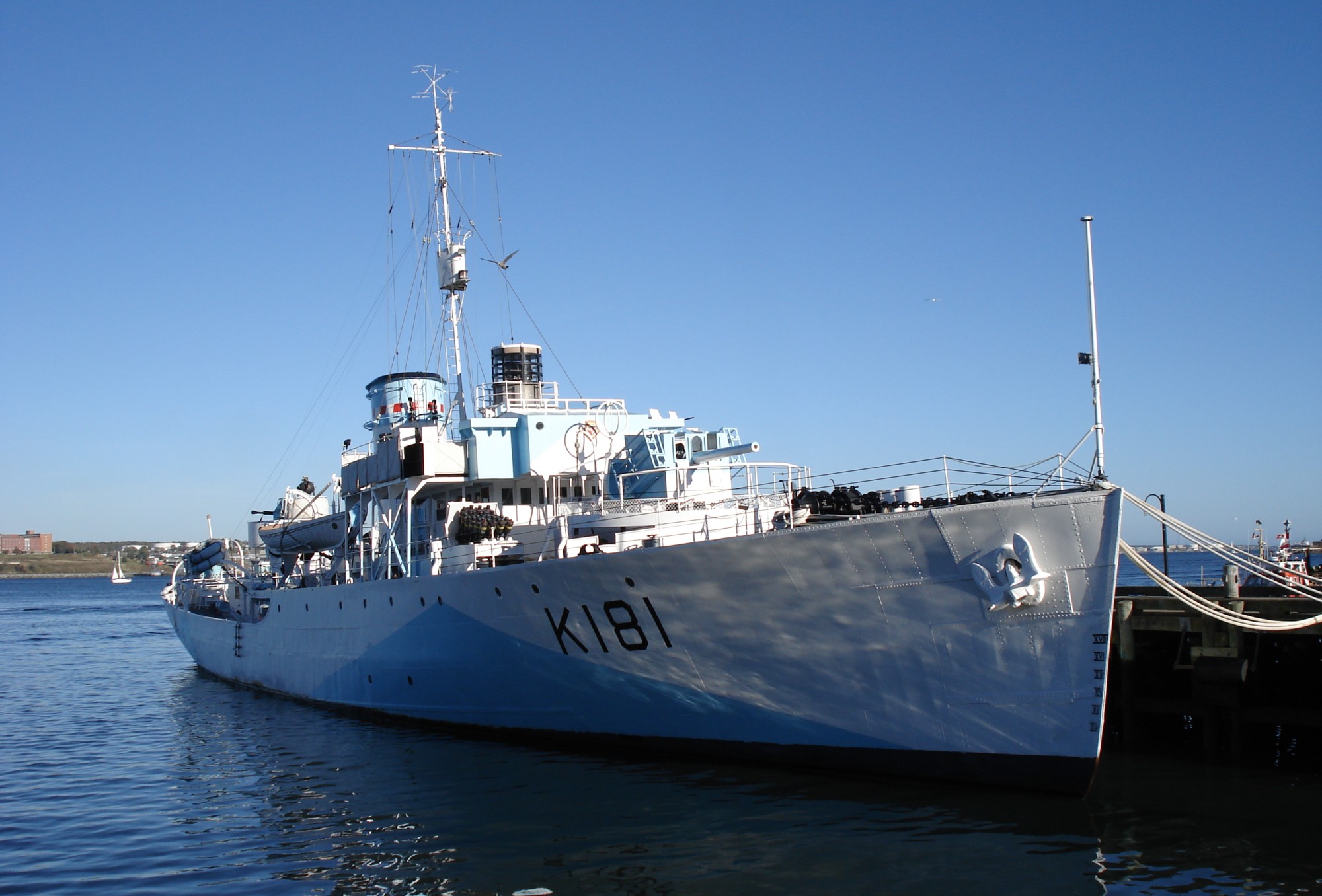
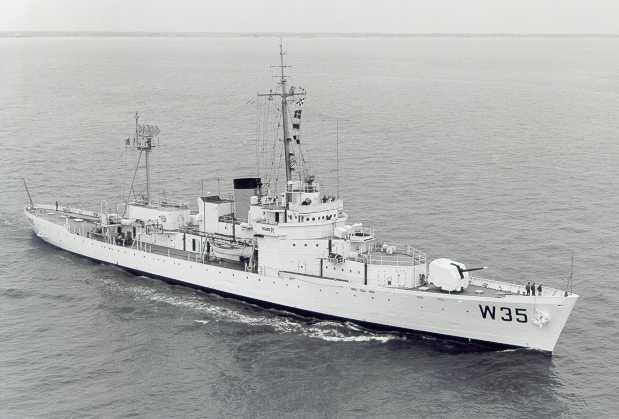
 In Newfoundland on 9 August 1941, President
In Newfoundland on 9 August 1941, President
 * Escort Group A-1: and s , and with Flower-class corvettes , and Rohwer & Hummelchen (1992) p. 124
* Escort Group A-2: ''Gleaves''-class destroyer and USCG Treasury-class cutter with Flower-class corvettes , , , , and
* Escort Group A-3: ''Gleaves''-class destroyer with USCG Treasury-class cutter and Flower-class corvettes , , and
* Escort Group A-4: ''Benson''-class destroyer and ''Clemson''-class destroyer with Flower-class corvettes ''Impulse'', , , , and , and
* Escort Group A-5: ''Gleaves''-class destroyer and with Flower-class corvettes , , and
* Escort Group B-1: H-class destroyer with ''Rockingham'', V-class destroyer , and Flower-class corvettes , and
* Escort Group A-1: and s , and with Flower-class corvettes , and Rohwer & Hummelchen (1992) p. 124
* Escort Group A-2: ''Gleaves''-class destroyer and USCG Treasury-class cutter with Flower-class corvettes , , , , and
* Escort Group A-3: ''Gleaves''-class destroyer with USCG Treasury-class cutter and Flower-class corvettes , , and
* Escort Group A-4: ''Benson''-class destroyer and ''Clemson''-class destroyer with Flower-class corvettes ''Impulse'', , , , and , and
* Escort Group A-5: ''Gleaves''-class destroyer and with Flower-class corvettes , , and
* Escort Group B-1: H-class destroyer with ''Rockingham'', V-class destroyer , and Flower-class corvettes , and
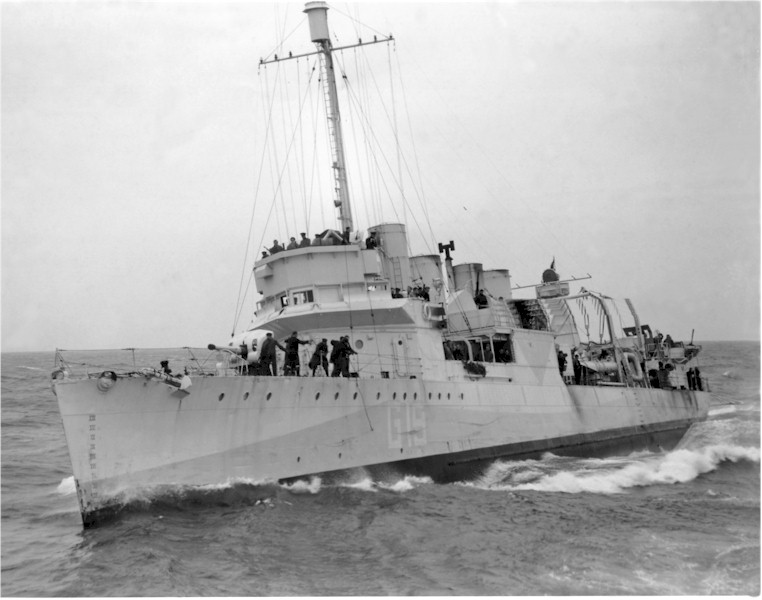 * Escort Group B2: H-class destroyer with Town-class destroyer ''Leamington'', V-class destroyer , and Flower-class corvettes , , and
* Escort Group B-3: H-class destroyer with Town-class destroyer ''Georgetown'',
* Escort Group B2: H-class destroyer with Town-class destroyer ''Leamington'', V-class destroyer , and Flower-class corvettes , , and
* Escort Group B-3: H-class destroyer with Town-class destroyer ''Georgetown'', 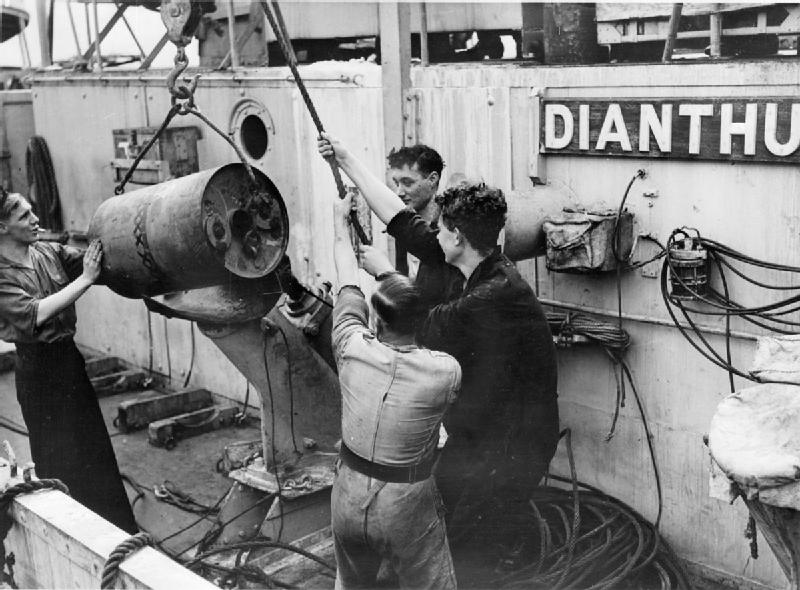 * Escort Group C-1: Canadian River-class destroyer and Town-class destroyer ''St. Croix'' with Flower-class corvettes , , and
* Escort Group C-2: Canadian River-class destroyer with Town-class destroyer ''Broadway'' and Flower-class corvettes , , and
* Escort Group C-3: Canadian River-class destroyers and with Flower-class corvettes , , and
* Escort Group C-4: Canadian River-class destroyers and with Town-class destroyer ''St. Francis'' and Flower-class corvettes , , and
* Escort Group C-1: Canadian River-class destroyer and Town-class destroyer ''St. Croix'' with Flower-class corvettes , , and
* Escort Group C-2: Canadian River-class destroyer with Town-class destroyer ''Broadway'' and Flower-class corvettes , , and
* Escort Group C-3: Canadian River-class destroyers and with Flower-class corvettes , , and
* Escort Group C-4: Canadian River-class destroyers and with Town-class destroyer ''St. Francis'' and Flower-class corvettes , , and

 Corvettes had adequate endurance for MOEF assignments, but the fuel economy of destroyers was poor at the speeds that convoys operated. The escort group leaders were modern destroyers with adequate endurance but, of the older destroyers allocated to trade convoy escort, only the ''Clemson'' subgroup of the Town-class destroyers proved suitable for MOEF assignments. ''Wickes''-class destroyers were useful for the Canadian WLEF and the American Iceland shuttle; but lacked endurance to stay with a trade convoy for the full distance covered by the MOEF Escort Groups. The Admiralty converted some V and W-class destroyers to long range escorts by removing the forward boiler and using the space for additional fuel tanks.
Nineteen modern American destroyers left the Atlantic to escort the battleships , , , and and the aircraft carriers , , and to the Pacific. The remaining American destroyers were diverted from MOEF assignments to troop convoys and in response to the
Corvettes had adequate endurance for MOEF assignments, but the fuel economy of destroyers was poor at the speeds that convoys operated. The escort group leaders were modern destroyers with adequate endurance but, of the older destroyers allocated to trade convoy escort, only the ''Clemson'' subgroup of the Town-class destroyers proved suitable for MOEF assignments. ''Wickes''-class destroyers were useful for the Canadian WLEF and the American Iceland shuttle; but lacked endurance to stay with a trade convoy for the full distance covered by the MOEF Escort Groups. The Admiralty converted some V and W-class destroyers to long range escorts by removing the forward boiler and using the space for additional fuel tanks.
Nineteen modern American destroyers left the Atlantic to escort the battleships , , , and and the aircraft carriers , , and to the Pacific. The remaining American destroyers were diverted from MOEF assignments to troop convoys and in response to the
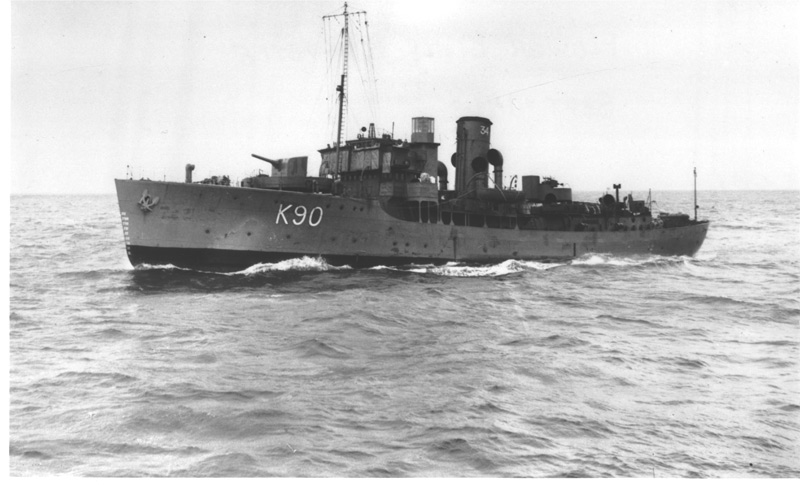 Flower-class corvettes , and ''Mignonette'' joined the group; and the low-endurance destroyers ''Leamington'' and ''Veteran'' were replaced by long-range V and W-class escorts and . Convoys SC 81, ON 97, SC 86, ON 107, HX 198, ON 118, HX 203, ON 128, HX 208, ON 138, HX 213, ON 148, HX 219 and ON 159 were escorted without loss. Convoy SC 118 lost eight ships. Convoys ON 170, SC 123 and ONS 4 were escorted without loss.
Flower-class corvettes , and ''Mignonette'' joined the group; and the low-endurance destroyers ''Leamington'' and ''Veteran'' were replaced by long-range V and W-class escorts and . Convoys SC 81, ON 97, SC 86, ON 107, HX 198, ON 118, HX 203, ON 128, HX 208, ON 138, HX 213, ON 148, HX 219 and ON 159 were escorted without loss. Convoy SC 118 lost eight ships. Convoys ON 170, SC 123 and ONS 4 were escorted without loss.
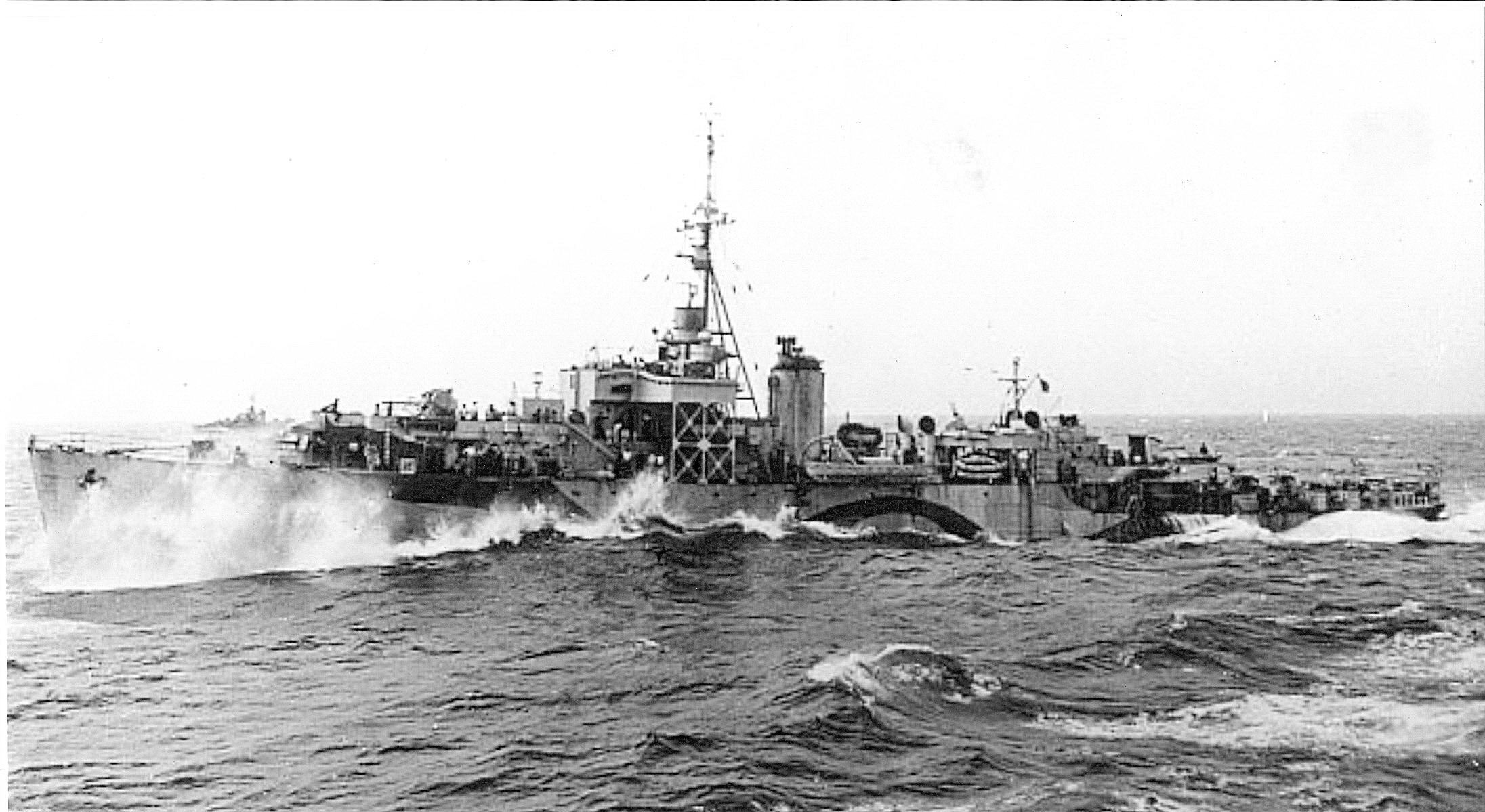 Escort Group B-5 returned to MOEF with H-class destroyer ''Havelock'', Flower-class corvettes ''Pimpernel'', ''Godetia'', ''Saxifrage'', and and with the new River-class frigate replacing the old destroyers. Convoy ON 168 was escorted without loss. Convoy SC 122 lost eight ships. Convoy SC 126 was escorted without loss.
River-class frigates brought two significant advantages to MOEF. Their numbers allowed the older escorts time to refit with modern sensors like 10-centimeter
Escort Group B-5 returned to MOEF with H-class destroyer ''Havelock'', Flower-class corvettes ''Pimpernel'', ''Godetia'', ''Saxifrage'', and and with the new River-class frigate replacing the old destroyers. Convoy ON 168 was escorted without loss. Convoy SC 122 lost eight ships. Convoy SC 126 was escorted without loss.
River-class frigates brought two significant advantages to MOEF. Their numbers allowed the older escorts time to refit with modern sensors like 10-centimeter
World War II
World War II or the Second World War, often abbreviated as WWII or WW2, was a world war that lasted from 1939 to 1945. It involved the vast majority of the world's countries—including all of the great powers—forming two opposing ...
trade convoy
A convoy is a group of vehicles, typically motor vehicles or ships, traveling together for mutual support and protection. Often, a convoy is organized with armed defensive support and can help maintain cohesion within a unit. It may also be used ...
s between Canada and Newfoundland, and the British Isles
The British Isles are a group of islands in the North Atlantic Ocean off the north-western coast of continental Europe, consisting of the islands of Great Britain, Ireland, the Isle of Man, the Inner and Outer Hebrides, the Northern Isles, ...
. The allocation of United States, British, and Canadian escorts to these convoys reflected preferences of the United States upon their declaration of war, and the organisation persisted through the winter of 1942–43 despite withdrawal of United States ships from the escort groups. By the summer of 1943, United States Atlantic escorts were focused on the faster CU convoys
The CU convoys were a World War II series of fast trans-Atlantic convoys to the British Isles. The earliest convoys of the series were tankers sailing directly from petroleum refineries at Curaçao to the United Kingdom. Most convoys of the ...
and the UG convoys between Chesapeake Bay and the Mediterranean Sea; and only British and Canadian escorts remained on the HX, SC and ON convoys.


Background
On the basis of experience duringWorld War I
World War I (28 July 1914 11 November 1918), often abbreviated as WWI, was one of the deadliest global conflicts in history. Belligerents included much of Europe, the Russian Empire, the United States, and the Ottoman Empire, with fightin ...
, the Admiralty instituted trade convoys in United Kingdom coastal waters from September 1939. Anti-submarine escorts were allocated on the basis of perceived threat. Early German Type II submarine
The Type II U-boat was designed by Nazi Germany as a coastal U-boat, modeled after the CV-707 submarine, which was designed by the Dutch dummy company NV Ingenieurskantoor voor Scheepsbouw Den Haag (I.v.S) (set up by Germany after World War ...
s from bases in Germany were unable to operate effectively beyond European coastal waters. Following acquisition of bases in Norway
Norway, officially the Kingdom of Norway, is a Nordic country in Northern Europe, the mainland territory of which comprises the western and northernmost portion of the Scandinavian Peninsula. The remote Arctic island of Jan Mayen and the ...
and France, German Type IX submarines and German Type VII submarine
Type VII U-boats were the most common type of German World War II U-boat. 703 boats were built by the end of the war. The lone surviving example, , is on display at the Laboe Naval Memorial located in Laboe, Schleswig-Holstein, Germany.
Co ...
s refuelled by German Type XIV submarine
The Type XIV U-boat was a modification of the Type IXD, designed to resupply other U-boats, being the only submarine tenders built which were not surface ships. It was nicknamed the "''Milchkuh/Milchkühe (pl.)''" (milk cows) or ''U-Tanker''.
...
s operated in the mid-Atlantic beyond the range of patrolling aircraft. Many anti-submarine escorts lacked the endurance to accompany convoys through the mid-Atlantic. HX 129 left Halifax on 27 May 1941 as the first convoy to receive escort for the entire trip. Escorts based in Halifax Harbour handed HX 129 off to escorts based in Newfoundland who subsequently transferred HX 129 to escorts based in Iceland
Iceland ( is, Ísland; ) is a Nordic island country in the North Atlantic Ocean and in the Arctic Ocean. Iceland is the most sparsely populated country in Europe. Iceland's capital and largest city is Reykjavík, which (along with its s ...
who in turn delivered HX 129 to escorts based in the Western Approaches
The Western Approaches is an approximately rectangular area of the Atlantic Ocean lying immediately to the west of Ireland and parts of Great Britain. Its north and south boundaries are defined by the corresponding extremities of Britain. The c ...
.
American escorts
 In Newfoundland on 9 August 1941, President
In Newfoundland on 9 August 1941, President Franklin D. Roosevelt
Franklin Delano Roosevelt (; ; January 30, 1882April 12, 1945), often referred to by his initials FDR, was an American politician and attorney who served as the 32nd president of the United States from 1933 until his death in 1945. As the ...
agreed to provide American destroyers for the Canada to Iceland
Iceland ( is, Ísland; ) is a Nordic island country in the North Atlantic Ocean and in the Arctic Ocean. Iceland is the most sparsely populated country in Europe. Iceland's capital and largest city is Reykjavík, which (along with its s ...
portion of HX convoys and westbound ON convoys. HX 150 sailed 16 September 1941 as the first convoy with American escort. ON 18 sailed 24 September as the first westbound convoy with American escort. The Royal Canadian Navy
The Royal Canadian Navy (RCN; french: Marine royale canadienne, ''MRC'') is the naval force of Canada. The RCN is one of three environmental commands within the Canadian Armed Forces. As of 2021, the RCN operates 12 frigates, four attack submar ...
continued to escort the SC convoys and their slower ON counterparts. Canadian escort groups were increased from a nominal strength of four ships to six – typically one Canadian River-class destroyer with five s.
The was torpedoed while escorting Convoy SC 48 on 17 October 1941. ''Clemson''-class destroyer was torpedoed and sunk on 31 October 1941 while escorting Convoy HX 156. When the United States declared war, American escort groups typically contained five destroyers, although six United States Coast Guard
The United States Coast Guard (USCG) is the maritime security, search and rescue, and law enforcement service branch of the United States Armed Forces and one of the country's eight uniformed services. The service is a maritime, military, mu ...
s were included within the pool of ships rotating in and out of these escort groups.
Long-range escort organization
As the United States Navy struggled to find enough destroyers to meet escort needs for both the Pacific and the vulnerable Atlantic coastal shipping, the shorter great-circle route from Newfoundland to theBritish Isles
The British Isles are a group of islands in the North Atlantic Ocean off the north-western coast of continental Europe, consisting of the islands of Great Britain, Ireland, the Isle of Man, the Inner and Outer Hebrides, the Northern Isles, ...
was considered as a means of eliminating meeting point delays and reducing the number of destroyers required for escort of convoys between Canada and the United Kingdom. Initial proposals by the United States on 24 January 1942 produced an agreement in early February for a Mid-Ocean Escort Force organisation of fourteen Escort Groups. American-led Escort Groups were prefixed with the letter "A"; while "B" indicated British-led Escort Groups and "C" designated Canadian-led Escort Groups. Fifteen United States destroyers, fifteen Royal Navy destroyers and twelve Canadian destroyers were to provide the striking power of these escort groups while 52 British and 49 Canadian Flower-class corvettes were to perform the patrolling role. Approximately one-third of the theoretical MOEF escort Group strength of three destroyers and seven corvettes was unavailable at any given time. Half of the unavailable ships needed storm or battle damage repairs, and the remainder were undergoing normal refit and training.
Each MOEF escort Group worked in a 33-day cycle allowing nine and one-half days with a westbound ON convoy, six days in St. John's, Newfoundland, nine and one-half days with an eastbound HX or SC convoy, and 8 days refit in Derry. The shorter routing away from Iceland eliminated the need for most escorts to attempt maintenance in Iceland's poorly equipped Hvalfjörður
Hvalfjörður (, "whale fjord") is situated in the west of Iceland between Mosfellsbær and Akranes. The fjord is approximately 30 km long and 5 km wide.
The origin of the name Hvalfjörður is uncertain. Certainly today there is no pr ...
anchorage; but the United States was required to maintain an additional force of five destroyers in Iceland
Iceland ( is, Ísland; ) is a Nordic island country in the North Atlantic Ocean and in the Arctic Ocean. Iceland is the most sparsely populated country in Europe. Iceland's capital and largest city is Reykjavík, which (along with its s ...
to escort ships between trans-Atlantic convoys and United States military occupation bases. The Royal Navy continued to provide an eastern local escort force of naval trawlers in the Western Approaches
The Western Approaches is an approximately rectangular area of the Atlantic Ocean lying immediately to the west of Ireland and parts of Great Britain. Its north and south boundaries are defined by the corresponding extremities of Britain. The c ...
while Canada continued to provide a Western Local Escort Force (WLEF) of corvettes, minesweepers, and short-range destroyers between Halifax Harbour and Newfoundland.
Initial MOEF Escort Group composition
 * Escort Group A-1: and s , and with Flower-class corvettes , and Rohwer & Hummelchen (1992) p. 124
* Escort Group A-2: ''Gleaves''-class destroyer and USCG Treasury-class cutter with Flower-class corvettes , , , , and
* Escort Group A-3: ''Gleaves''-class destroyer with USCG Treasury-class cutter and Flower-class corvettes , , and
* Escort Group A-4: ''Benson''-class destroyer and ''Clemson''-class destroyer with Flower-class corvettes ''Impulse'', , , , and , and
* Escort Group A-5: ''Gleaves''-class destroyer and with Flower-class corvettes , , and
* Escort Group B-1: H-class destroyer with ''Rockingham'', V-class destroyer , and Flower-class corvettes , and
* Escort Group A-1: and s , and with Flower-class corvettes , and Rohwer & Hummelchen (1992) p. 124
* Escort Group A-2: ''Gleaves''-class destroyer and USCG Treasury-class cutter with Flower-class corvettes , , , , and
* Escort Group A-3: ''Gleaves''-class destroyer with USCG Treasury-class cutter and Flower-class corvettes , , and
* Escort Group A-4: ''Benson''-class destroyer and ''Clemson''-class destroyer with Flower-class corvettes ''Impulse'', , , , and , and
* Escort Group A-5: ''Gleaves''-class destroyer and with Flower-class corvettes , , and
* Escort Group B-1: H-class destroyer with ''Rockingham'', V-class destroyer , and Flower-class corvettes , and
 * Escort Group B2: H-class destroyer with Town-class destroyer ''Leamington'', V-class destroyer , and Flower-class corvettes , , and
* Escort Group B-3: H-class destroyer with Town-class destroyer ''Georgetown'',
* Escort Group B2: H-class destroyer with Town-class destroyer ''Leamington'', V-class destroyer , and Flower-class corvettes , , and
* Escort Group B-3: H-class destroyer with Town-class destroyer ''Georgetown'', B-class destroyer
B class may refer to:
Ships
* Burak-class corvette, B-class corvette of the Turkish Navy
* A- and B-class destroyer, B-class destroyer, launched in 1930 for the British Royal Navy
* B-class destroyer (1913), British torpedo boat destroyers
* B- ...
, and Flower-class corvettes and , Free French and
* Escort Group B-4: H-class destroyer with Town-class destroyer ''Roxborough'', W-class destroyer , and Flower-class corvettes , and
* Escort Group B-5: H-class destroyer with Town-class destroyer ''Caldwell'', V- and W-class destroyers and , and Flower-class corvettes , and
 * Escort Group C-1: Canadian River-class destroyer and Town-class destroyer ''St. Croix'' with Flower-class corvettes , , and
* Escort Group C-2: Canadian River-class destroyer with Town-class destroyer ''Broadway'' and Flower-class corvettes , , and
* Escort Group C-3: Canadian River-class destroyers and with Flower-class corvettes , , and
* Escort Group C-4: Canadian River-class destroyers and with Town-class destroyer ''St. Francis'' and Flower-class corvettes , , and
* Escort Group C-1: Canadian River-class destroyer and Town-class destroyer ''St. Croix'' with Flower-class corvettes , , and
* Escort Group C-2: Canadian River-class destroyer with Town-class destroyer ''Broadway'' and Flower-class corvettes , , and
* Escort Group C-3: Canadian River-class destroyers and with Flower-class corvettes , , and
* Escort Group C-4: Canadian River-class destroyers and with Town-class destroyer ''St. Francis'' and Flower-class corvettes , , and
Shortage of destroyers

 Corvettes had adequate endurance for MOEF assignments, but the fuel economy of destroyers was poor at the speeds that convoys operated. The escort group leaders were modern destroyers with adequate endurance but, of the older destroyers allocated to trade convoy escort, only the ''Clemson'' subgroup of the Town-class destroyers proved suitable for MOEF assignments. ''Wickes''-class destroyers were useful for the Canadian WLEF and the American Iceland shuttle; but lacked endurance to stay with a trade convoy for the full distance covered by the MOEF Escort Groups. The Admiralty converted some V and W-class destroyers to long range escorts by removing the forward boiler and using the space for additional fuel tanks.
Nineteen modern American destroyers left the Atlantic to escort the battleships , , , and and the aircraft carriers , , and to the Pacific. The remaining American destroyers were diverted from MOEF assignments to troop convoys and in response to the
Corvettes had adequate endurance for MOEF assignments, but the fuel economy of destroyers was poor at the speeds that convoys operated. The escort group leaders were modern destroyers with adequate endurance but, of the older destroyers allocated to trade convoy escort, only the ''Clemson'' subgroup of the Town-class destroyers proved suitable for MOEF assignments. ''Wickes''-class destroyers were useful for the Canadian WLEF and the American Iceland shuttle; but lacked endurance to stay with a trade convoy for the full distance covered by the MOEF Escort Groups. The Admiralty converted some V and W-class destroyers to long range escorts by removing the forward boiler and using the space for additional fuel tanks.
Nineteen modern American destroyers left the Atlantic to escort the battleships , , , and and the aircraft carriers , , and to the Pacific. The remaining American destroyers were diverted from MOEF assignments to troop convoys and in response to the U-boat
U-boats were naval submarines operated by Germany, particularly in the First and Second World Wars. Although at times they were efficient fleet weapons against enemy naval warships, they were most effectively used in an economic warfare ro ...
's Second happy time off the American east coast. Escort Groups A-1 and A-2 were disbanded when their modern American destroyer leader
Destroyer leader (DL) was the United States Navy designation for large destroyers from 9 February 1951 through the early years of the Cold War. United States ships with hull classification symbol DL were officially frigates from 1 January 1955Blac ...
s were assigned elsewhere. Escort Groups A-4 and A-5 were redesignated B6 and B7, respectively, when the Royal Navy assigned F-class destroyers and as leaders. Escort Group B5 was reassigned to Caribbean trade convoys in March 1942. Beginning in April, the following eleven groups escorted HX convoys, SC convoys, and ON convoys through the winter of 1942–43:
Escort Group A-3
* Convoy HX 185 was escorted without loss.Hague (2000) p. 128 ''Gleaves''-class destroyer ''Gleaves'' left the escort group after convoy ON 92 lost seven ships. USCG Treasury-class cutters ''Spencer'' and assumed escort leader responsibility. Flower-class corvettes ''Mayflower'' and replaced Flower-class corvettes ''Chilliwack'', ''Shediac'' and ''Algoma''.Milner (1985) pp. 290–1 * Convoy HX 190 was escorted without loss. * Convoy ON 102 lost one ship torpedoed by .Rohwer & Hummelchen (1992) p. 139 * Convoys HX 196 and ON 114 were escorted without loss.Hague (2000) pp. 128, 158 * Convoy SC 95 lost one ship torpedoed by .Rohwer & Hummelchen (1992) p. 157 * Convoy ON 125 was escorted without loss.Hague (2000) p. 158 Flower-class corvette ''Rosthern'' joined the group. * Convoy SC 100 lost three ships torpedoed by , and . * Convoys ON 135 and HX 212 were escorted without loss. Flower-class corvette ''Dianthus'' replaced Flower-class corvettes ''Mayflower'' and ''Bittersweet''. * Convoy ON 145 lost one ship torpedoed by .Rohwer & Hummelchen (1992) p. 167 Flower-class corvette rotated into the group. * Convoys SC 111, ON 156 and HX 223 were escorted without loss.Hague (2000) pp. 128, 135 & 158 * Convoy ON 166 lost eleven ships. * Convoy SC 121 lost seven ships.Hague (2000) p. 135 * Convoy ON 175 was escorted without loss. * Convoy HX 233 lost one ship torpedoed by . The escort group was then redesignated C-5 under Canadian command after the USCG Treasury-class cutters were reassigned for conversion to amphibious force flagships.Escort Group B-1
Flower-class corvettes , and joined the group; and ''Venomous'' was replaced by the long-range W-class escort .Rohwer & Hummelchen (1992) p. 227 Convoys HX 187, ON 96, HX 193, ON 108, SC 92, ON 119, HX 201, ON 124, HX 206, ON 134, SC 105, HX 215, ON 151, SC 114, ON 162, SC 119, ON 171 and HX 230 were escorted without loss. Convoy ON 178 lost three ships torpedoed by and .Rohwer & Hummelchen (1992) p. 206Escort Group B-2
 Flower-class corvettes , and ''Mignonette'' joined the group; and the low-endurance destroyers ''Leamington'' and ''Veteran'' were replaced by long-range V and W-class escorts and . Convoys SC 81, ON 97, SC 86, ON 107, HX 198, ON 118, HX 203, ON 128, HX 208, ON 138, HX 213, ON 148, HX 219 and ON 159 were escorted without loss. Convoy SC 118 lost eight ships. Convoys ON 170, SC 123 and ONS 4 were escorted without loss.
Flower-class corvettes , and ''Mignonette'' joined the group; and the low-endurance destroyers ''Leamington'' and ''Veteran'' were replaced by long-range V and W-class escorts and . Convoys SC 81, ON 97, SC 86, ON 107, HX 198, ON 118, HX 203, ON 128, HX 208, ON 138, HX 213, ON 148, HX 219 and ON 159 were escorted without loss. Convoy SC 118 lost eight ships. Convoys ON 170, SC 123 and ONS 4 were escorted without loss.
Escort Group B-3
Low-endurance destroyers ''Georgetown'' and ''Bulldog'' were replaced by the E-class destroyer and the Polish destroyers and . Flower-class corvette replaced ''Heartsease'' and the four corvettes with Free French crews (''Aconit'', ''Lobelia'', ''Renoncule'' and ''Roselys'') were assigned to this group. Convoys HX 188, ON 98, HX 194, ON 110, SC 93, ON 121, HX 202, ON 126, HX 207, ON 136, SC 106, ON 146, HX 218, ON 157 and SC 117 were escorted without loss. Convoy ON 167 lost two ships. Convoy HX 228 lost four ships torpedoed by , and .Rohwer & Hummelchen (1992) p. 198 ''U-444'' was rammed by the group leader ''Harvester''. ''Harvester'' was then torpedoed by . ''U-432'' was then sunk by ''Aconit''. Thornycroft type leader was assigned as group leader replacement. Convoy ON 174 was escorted without loss.Hague (2000) p. 159 Convoy HX 232 lost three ships torpedoed by and .Escort Group B-4
Flower-class corvettes , and joined the group; and the low-endurance destroyer ''Roxborough'' was replaced by the Town-class destroyer ''Beverley''. Convoys SC 82, ON 99, SC 87, ON 109, HX 199, ON 120, HX 204 and ON 130 were escorted without loss. Convoy HX 209 lost one ship torpedoed by . Convoys ON 140, HX 214, ON 150, HX 220, ON 161 and ON 169 were escorted without loss. Convoy HX 229 lost twelve ships. Convoy ON 176 lost one ship and ''Beverley'' was torpedoed by . Convoy HX 234 lost one ship torpedoed by .Escort Group B-6
The Royal Norwegian Navy-manned Flower-class corvettes ''Andenes'', ''Eglantine'', ''Rose'', ''Potentilla'', and from Escort Group A4, and the new leader F-class destroyer ''Fame'' were joined by the V-class (which had been reconstructed as a long range escort), the Town-class destroyer ''Ramsey'', and the British Flower-class corvettes ''Kingcup'' and ''Vervain''. Convoys SC 83, ON 101, SC 88, ON 111 and HX 200 were escorted without loss.Convoy ON 122
Convoy ON 122 was a trade convoy of merchant ships during the second World War. It was the 122nd of the numbered series of ON convoys Outbound from the British Isles to North America. The ships departed Liverpool on 15 August 1942 and were joine ...
lost four ships torpedoed by , and . Convoys HX 205 and ON 132 were escorted without loss. Convoy SC 104 lost seven ships. Convoy ON 144
Convoy ON 144 was a trade convoy of merchant ships during the Second World War. It was the 144th of the numbered series of ON convoys Outbound from the British Isles to North America. The ships departed Liverpool on 7 November 1942 and were join ...
lost five ships torpedoed by , and .Rohwer & Hummelchen (1992) p. 177 ''Montbretia'' was torpedoed by . Convoy HX 217 lost two ships torpedoed by and . Convoys ON 155, SC 116, ON 165, HX 227, ONS 1 and SC 125 were escorted without loss.
Escort Group B-7
The Flower-class corvette ''Loosestrife'' from Escort Group A-5, and the new leader F-class destroyer ''Firedrake'' were joined by the Town-class destroyers ''Chesterfield'' and ''Ripley'' and by the Flower-class corvettes , , , and . Convoys HX 186, ON 94, HX 192, ON 106, SC 91, ON 117, SC 103, ON 142 and HX 216 were escorted without loss. Convoy ON 153 lost three ships torpedoed by , and .Rohwer & Hummelchen (1992) p. 182 On 17 December 1942 HMS ''Firedrake'' was torpedoed by and sank. The D-class destroyer was assigned as replacement group leader; and the new joined the group. Convoys SC 115, ON 164, SC 120 and ON 173 were escorted without loss. Convoy HX 231 lost three ships torpedoed by , and . Convoy ONS 5 lost eleven ships.Escort Group C-1
Corvette ''Buctouche'' was replaced by Flower-class corvettes , ''Chilliwack'', and .Milner (1985) p. 285 Convoy HX 189 was escorted without loss. Convoy ON 100 lost three ships torpedoed by and . Convoys HX 195 and ON 112 were escorted without loss. Convoy SC 94 lost ten ships. Group leader ''Assiniboine'' and Flower-class corvettes ''Dianthus'', ''Nasturtium'' and ''Primrose'' were replaced by destroyer ''St. Laurent'' and Flower-class corvettes , , and ''Shediac''. Convoys ON 123, SC 99, ON 133, HX 211, ON 143 and SC 110 were escorted without loss. Flower-class corvettes ''Orillia'', ''Chambly'' and ''Eyebright'' rotated out of the group.Milner (1985) p. 287 Convoy ON 154 lost thirteen ships. Convoy HX 222 lost one ship torpedoed by .Rohwer & Hummelchen (1992) p. 188 Flower-class corvette ''Chilliwack'' was replaced by new River-class frigate . Convoys ONS 2 and SC 127 were escorted without loss.Escort Group C-2
Convoys SC 84, ON 103 and SC 89 were escorted without loss.Hague (2000) pp. 135 & 158 Destroyer replaced destroyer ''St. Laurent''; and Flower-class corvette ''Dauphin'' joined the group.Milner (1985) pp. 287–8 Convoy ON 113 lost three ships torpedoed by , and while Town-class destroyer ''St. Croix'' sank . Convoys HX 201 and ON 119 were escorted without loss. Convoy SC 97 lost two ships torpedoed by while ''Morden'' sank . Convoys ON 129 and SC 102 were escorted without loss. Destroyer replaced destroyer ''Burnham''; and Flower-class corvettes and ''Primrose'' replaced Flower-class corvettes ''Dauphin'' and ''Brandon''. Convoy ON 139 lost two ships torpedoed by . Flower-class corvette ''Orillia'' joined the group. Convoys SC 108, ON 149 and SC 113 were escorted without loss. New River-class frigates and joined the group. Convoys ON 160, HX 225 and ON 179 were escorted without loss.Escort Group C-3
Convoys ON 93, HX 191, ON 104 and SC 90 were escorted without loss. Flower-class corvette ''Camrose'' was replaced by corvette ''Agassiz''.Milner (1985) pp. 288–9 Convoy ON 115 lost two ships torpedoed by and while ''Skeena'' and Flower-class corvette ''Wetaskiwin'' sank . Convoys HX 202, ON 121, SC 98, ON 131, HX 210 and ON 141 were escorted without loss. Convoy SC 109 lost one ship torpedoed by and ''Saguenay'' was irreparably damaged when depth charges blew off its stern following a collision. Town-class destroyer ''Burnham'' replaced ''Saguenay''. Flower-class corvettes ''Wetaskiwin'', ''Sackville'', ''Galt'' and ''Agassiz'' were replaced by corvettes ''Bittersweet'', ''Eyebright'', and ''Mayflower''. The new River-class frigate joined the group. Convoys ON 152, HX 221, ON 163, HX 226, ON 172, SC 124 and ON 180 were escorted without loss.Escort Group C-4
Convoys ON 95, SC 85, ON 105, HX 197, ON 116 and SC 96 were escorted without loss. Destroyer ''St. Francis'' was replaced by Town-class destroyer ''St. Croix'' and Flower-class corvettes ''Lethbridge'', ''Prescott'' and ''Eyebright'' were replaced by corvettes , and .Milner (1985) pp. 289–90 Convoy ON 127 lost six ships; and ''Ottawa'' was torpedoed by . Convoys SC 101 and ON 137 were escorted without loss. Convoy SC 107 lost fifteen ships. Destroyer ''St. Croix'' was replaced by Town-class destroyer ''Churchill'' and Flower-class corvette ''Arvida'' was replaced by corvettes ''Brandon'' and ''Collingwood''. Convoys ON 147, SC 112 and ON 158 were escorted without loss. Convoy HX 224 lost two ships torpedoed by . Convoys ON 177 and HX 235 were escorted without loss.Spring of 1943
 Escort Group B-5 returned to MOEF with H-class destroyer ''Havelock'', Flower-class corvettes ''Pimpernel'', ''Godetia'', ''Saxifrage'', and and with the new River-class frigate replacing the old destroyers. Convoy ON 168 was escorted without loss. Convoy SC 122 lost eight ships. Convoy SC 126 was escorted without loss.
River-class frigates brought two significant advantages to MOEF. Their numbers allowed the older escorts time to refit with modern sensors like 10-centimeter
Escort Group B-5 returned to MOEF with H-class destroyer ''Havelock'', Flower-class corvettes ''Pimpernel'', ''Godetia'', ''Saxifrage'', and and with the new River-class frigate replacing the old destroyers. Convoy ON 168 was escorted without loss. Convoy SC 122 lost eight ships. Convoy SC 126 was escorted without loss.
River-class frigates brought two significant advantages to MOEF. Their numbers allowed the older escorts time to refit with modern sensors like 10-centimeter radar
Radar is a detection system that uses radio waves to determine the distance ('' ranging''), angle, and radial velocity of objects relative to the site. It can be used to detect aircraft, ships, spacecraft, guided missiles, motor vehicles, we ...
and modern anti-submarine weapons like the Hedgehog
A hedgehog is a spiny mammal of the subfamily Erinaceinae, in the eulipotyphlan family Erinaceidae. There are seventeen species of hedgehog in five genera found throughout parts of Europe, Asia, and Africa, and in New Zealand by introductio ...
projector. Destroyers replaced by new frigates were formed into mobile support groups able to move rapidly to convoys coming under attack. Through 1943, new escort carriers became available to increase the surveillance capability of support groups. As the winter weather cleared, new Very Long Range Consolidated B-24 Liberator patrol bombers extended surveillance into the mid-Atlantic.Middlebrook (1976) p. 53
See also
* Mid-Ocean Meeting Point *Mid-Atlantic Gap
The Mid-Atlantic gap is a geographical term applied to an undefended area beyond the reach of land-based RAF Coastal Command antisubmarine (A/S) aircraft during the Battle of the Atlantic in the Second World War. It is frequently known as The Bla ...
Notes
References
* * * * * * * * * * * {{cite book , title=The Atlantic Campaign , author=van der Vat, Dan , publisher=Harper & Row , year=1988 , isbn=0-06-015967-7 , url=https://archive.org/details/atlanticcampaign00vand Battle of the Atlantic Escort Groups of the Royal Navy in World War II North Atlantic convoys of World War II Royal Canadian Navy Naval battles and operations of World War II involving the United Kingdom